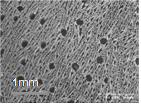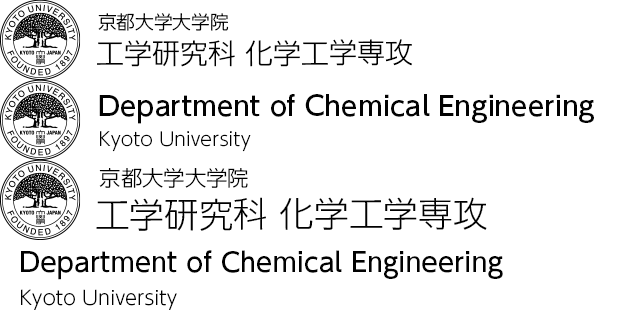Materials Process Engineering
Academic Staff
Masahiro OHSHIMA
 Professor (Graduate School of Engineering)
Professor (Graduate School of Engineering)
Research Topics
Our research interests is to create new products by material processing. To create material products for a specified functions, one has to control nano-micro scale material structure, bulk properties in a certain processing field such as high shear, temperature or pressure fields. Understanding the micro-macro scales relationship between material structure and fields condition is a key of creation. Our research activities focus on elucidation of the relationship and development of a new processing technology for creating new functional materials. One of the research topics is to foams for engineering use.
Contacts
Room 019, Bldg. A4, Katsura Campus
TEL: +81-75-383-2666
FAX: +81-75-383-2646
E-mail: oshima![]() cheme.kyoto-u.ac.jp
cheme.kyoto-u.ac.jp
Shinsuke NAGAMINE
 Associate Professor (Graduate School of Engineering)
Associate Professor (Graduate School of Engineering)
Research Topics
My main research topic is the synthesis of porous solids and microparticles with the highly controlled structures and morphologies in nano- or micrometer scale. The novel synthesis technique of inorganic hollow micropaticles based on the liquid-liquid interfacial solid precipitation is currently being developed.
Contacts
Room 019, Bldg. A4, Katsura Campus
TEL: +81-75-383-2686
FAX: +81-75-383-2646
E-mail: nagamine![]() cheme.kyoto-u.ac.jp
cheme.kyoto-u.ac.jp
Yuta HIKIMA
 Assistant Professor (Graduate School of Engineering)
Assistant Professor (Graduate School of Engineering)
Research Topics
- Infrared / Near-Infrared Spectroscopic Imaging
- Polarization Analysis
Contacts
Room 021, Bldg. A4, Katsura Campus
TEL: +81-75-383-2696
FAX: +81-75-383-2646
E-mail: hikima![]() cheme.kyoto-u.ac.jp
cheme.kyoto-u.ac.jp
Introduction to Research
Modern society is deeply indebted to various chemical materials for providing the several products to our life. Among those materials, polymer is one of the materials having the large potentials of giving rise to various functions, such as lightness, flexibility, elasticity, and fluidity. The material functions are strongly related with the material structures in the level from nano, micro to macro-scales. Employing the computer simulation and modern processing machines, our laboratory is developing new material processing technologies for creating new functional materials. Research and development mainly focus on controlling the material structures created by diffusion, phase separation, nucleation and growth and developing the optimal processing device for the control. Integration of supercritical fluid with present plastic processing technologies is one of our interests of our research. Also, material processing in mirco-space, i.e., mirco chemical processes, is our interest. Latest research topics are micro-cellular polymer foaming, nucleation and growth mechanism, mass transfer induced phase separation in drying and crystallization as well as micro-chemical devise developments. Some of them are introduced as follows:
1. Scf CO2 assisted polymer processing
When CO2 dissolves in polymer, polymer is plasticized. That is, viscosity is reduced, glass transition temperature is reduced and several other properties are changed. Taking advantage of these CO2 effects, new polymer-processing schemes, which can realize surface modification, nano-scale pattern transfer on polymer products and CNT infusion to polymer surface, are invented and patented. Fig.1 is a SEM image of Ni layer on a nylon substrate by electroless plating.

Fig. 1. Ni layer deposited on a polyamide 6 substrate by electroless plating technique. M: NiP, P:polyamide6.
2. Polymeric Foaming
Using CO2 as an environmentally benign foaming agent, thermoplastic polymers are foamed so as to create the micro/nano-cellular structure. Bubble nucleation and growth are phenomena to be analyzed and controlled. Nano-cellular foam was realized in PMMA-b-PS diblock polymer (Fig. 2).

Fig. 2. Nanocellular foam of PS-b-PMMA.
3. Formation of Self-organized Structure by drying polymeric solutions
Spin-casting of polymer blend solutions sometimes creates peculiar structure (Fig. 3). Formation mechanism of the morphology and its relationships with drying conditions are investigated.

Fig. 3. An SEM micrograph of PS/PEG 200 (70/30) (w/w) taken tilted at 60°.
Fig. 4 shows a successful preparation of a porous polymeric material, which has uni-directionally aligned channels with bimodal pore size distribution and interconnection to neighboring channels. It was made from a PLA/dioxane solution by a pseudo-steady state freezing and successive freeze-drying processes.

Fig. 4. SEM micrographs of the cross sectional area of PLA: perpendicular to freezing direction.
4. Hollow Nano-fibers by Electrospinning
Hollow nano-fibers of metal oxides are easily prepared by electrospinning a polymer aqueous solution and introducing the thread-like projected solution into the metal alkoxides in organic solvent. The rapid hydrolysis of the alkoxide at the water-oil interface results in the formation of core-sheath structure (Fig. 5).

Fig. 5. TiO2hollow nano-fibers by electrospinning.
